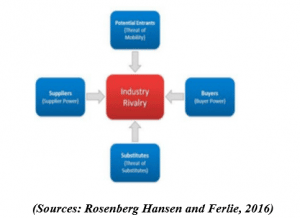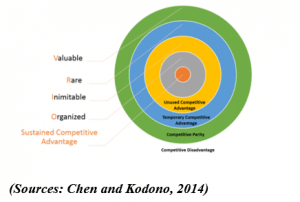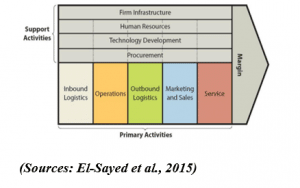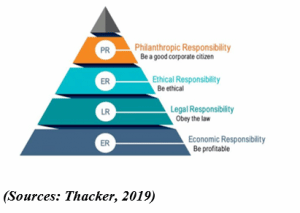Global Strategy and Sustainability Assignment Sample
Here’s the best Global Strategy and Sustainability Assignment Sample, written by the expert.
1. Introduction
The aim of this study is to prepare the strategic report for Amazon.com. This report would help the brand to analyze its current position and internal/external factors within which it able to explore global market. Based on analysis, recommendations would be provided for global development and sustainability aspects. Basically, Amazon is an American based e-retail firm based in Seattle, Washington which focuses on e-commerce, cloud computing, digital streaming and artificial intelligence (Amazon, 2021). It is one of the big five companies in US information technology industry along with Google, Microsoft and Facebook etc.
In regards to its history, it is launched in July 5, 1994 by Jeff Bezos in Bellevue. It started as an online marketplace for books but expanded to sell electronics, software and video games and apparel and furniture etc. so far, Amazon is indulge in the cost leadership and product differentiation positioning strategy as Amazon is started with selling of books in online but now it offers more than 100 products under single roof. Basically, it has low-price, extraordinary convenience, instant access and comprehensive selection (Zhao et al., 2016). Other than that, key challenges that Amazon is facing tend to be related increasing competition, changing sales tax, customer returns and price wars among competitors.
2. External Analysis of the Industry using 2 appropriate Strategic Models
In order to analyze the external influences on the online retail industry, there are two models are taken i.e. Porter Five forces model PESTLE analysis.
Porter Five Forces Model
- Bargaining Power of Buyer:-
There is high bargaining power of buyer exist in online retail industry as several small or big brands cropped up as today’s customers is well informed and has every piece of information at a single click. Apart from this, the existences of physical retail brands also give tough time to online retailers as customers have several options with them (Yunna and Yisheng, 2014). The loyalty of customers in retail industry is less only due to customers does not get any kind of losses after switching to another brand.
- Bargaining Power of Suppliers:- In e-retail industry, the bargaining power of suppliers is generally low to moderate. The cause behind this is the rules set by the brand and suppliers have to follow the code of conduct (Anastasiu et al., 2020). Most of the e-commerce’s brands are highly cautious about their supplier relationship, set code of conduct, fair wage and labor laws. In-spite of this, number of players in industry has been growing but the suppliers do not have many options with them. Therefore, they are bound to follow the rules.
- Threat of substituent’s:- There is moderate to high threat of substitution in online retail market and it is majorly related to strategies as every competitor in market put the cost low and tries to take competitive advantage (Jhamb, 2016). For the customers, the brand switching cost is also not there so it becomes easy for them to move towards another e-retail business easily.

- Threat of new entrants:- There is low to moderate threat of new entrants in this industry due to large number of investments are required to put in technology, human resources, marketing etc. However, the difficulty is in terms of building brand image and trust with the customers among in this tough competition. So, it can be stated that overall threat tends to be moderate.
- Rivalry in the industry:- There is high rivals are exist in the online retail industry as large number of players exist both local and global at large scale. This led the higher competition. apart from e-retailers, the large number of physical stores also give strong competitions as still there are people’s who prefer to buy product from stores only by touching it and then tried after that buy it (Zhao et al., 2016). So the overall rivalries between the brands are getting tedious day-by-day.
PESTEL Analysis
| Political Factor | There are several political threats occur for the e-retailers in different market. For example, some e-commerce’s firm like Amazon, E-bay in Asia pacific region has facing difficulty due to Red tape as this brand into extent their presences in Asian market with the help of political leaders (Zalengera et al., 2014). The changing political parties also influenced the e-business functions as without the support of government, e-retailers can’t function in local market. |
| Economic factors are very significant in terms of doing business as it’s must for e-retailers to analyze the people purchasing power. But for e-retailers, the recession time does not affect their functions due to people is ready to pay for their basic necessities so e-retailers are the one that made it available on low cost at their doorstep. So it can be stated that economic factors affects e-retailers business only in regards to technology adaptation, society changing needs and wants last, the less availability of resources (Nandonde, 2019). Otherwise, economic factors do not affect the e-retailer even at the time of recession. | Economical Factor |
| Social Factor | Socio-cultural factors have a deep impact over the e-retail business as for e-retailers to work in local market tend to be easier but for international market, the uncertainties exist. It is all related to the changing trend as mobile technology has totally transformed the e-retailing industry (Zahari and Romli, 2019). That’s why, it is stated that changing customer taste and preferences are the major ones to have impact on e-commerce’s industry. |
| The technology has a major role in the online industry as without having in place of sales technology or installation of right payment system then none of the customer take interest in e-retail business. | Technological Factor |
| Environmental Factor | Environmental factors also have a special importance’s among the e-retailers as they know about the present situation regards to the changing climatic condition, high disease spreading which allows e-retailer to focus on their packaging and recycling process (Aithal, 2016). |
| Legal compliances is important for e-retailers to follow in regards to labor law, employment and environmental laws etc. this supports them only to regulate their business in global market (Jones and Comfort, 2020). | Legal Factors |
3. Internal Analysis of Amazon.com using 2 appropriate Strategic Models
There are two models would use to analyze Amazon.com internal environment. These are VRIO and Value chain.
VRIO Model

VRIO indicates four question frameworks of value, rarity, inimitability and organization. it is used to uncover the sustained competitive advantage.
| Core Competency | Valuable | Rare | Inimitable | Organized | Implication |
| Brand Name | Yes | Yes | Yes | Yes | Competitive advantage |
| Customer Experience | Yes | Yes | No | Yes | Temporary Advantage |
| Research and development | Yes | Yes | Yes | Yes | Competitive advantage |
| Distribution Network | Yes | Yes | Yes | Yes | Competitive advantage |
| Customer Loyalty | Yes | Yes | No | Yes | Temporary Advantage |
This analysis indicated that Amazon consists of strong resources and capability to procure the customers and fulfill their desired needs and wants. However, e-commerce’s is a big brand name which has gain huge recognition among various customer segments (Pesic et al., 2013). Besides that, the firm also done their research and development activities on appropriate manner as they knows that Asian countries people are quite price-sensitive and something they ignore the quality so they focus with the cost leadership strategy in the countries like India, Bangladesh and China. Apart from this, it consists of strong distribution network that support toward the timely supplies to ordered goods to people. At the same time, the return policy also implemented well as customer get the delivery boy on time for the receiving orders and gets the new placement on time. These areas support the brand to achieve the competitive advantage and give threats to competitors.
Other than that, there are areas which are uncertain and these are customer experiences and loyalty as it is fact e-retailer market consist of lot of uncertainties of heavy competitors existences. In that case, it becomes problematic for the brand to retain the customers for longer duration. Since everyone in e-retailing industry come with substituent product and use of low-cost method in that case, the customer experiences and loyalty definitely tend to be uncertain (Buzatu et al., 2019). That’s why, this model clearly presented that Amazon is strong enough in its resources and capability to explore more local or global markets but the constant changes in market trends and competition rising are some of the areas that definitely hit the brand each time and at every region.
Value Chain Analysis

It helps to identify the business activities of Amazon that support to create value and competitive advantage to business. There are two ways to analyze the activities such as support activities and primary one.
Primary activities
- Inbound Logistics:- Amazon does not have long-term contracts with its vendors and it consist of its owned retail business named Fulfillment by Amazon. In this, it stocked their products and delivery also done from this place only.
- Operations:- Amazon has operations in three segments such as North America, International and Amazon web series (Jaligot et al., 2016).
- Outbound Logistics:- the firm outbound logistics integrates fulfillment centre’s within which it operates 109 centre’s around the globe. The use of robotics technology support to manage the receipts, stowing, picking and shipment of products.
- Marketing & Sales:- Amazon spent more on TV commercial for promotion of firm and to connect with small vendors for the product supplies.
- Services:- It provides all retail kind of services such as electronic, accessories and household products and now it involves in cloud-computing, artificial intelligences etc.
Supporting activities
- Firm Infrastructure:- Amazon consist of wide infrastructure in which it provides services to customers, sellers and developers through its website. It provide platform to small vendors to sell their product to Amazon and then it directly forward to final customers. Basically, firm infrastructure deals with both vendors as well as final consumers.
- Human resources:- Amazon consist of 798,000 full-time employees in its Seattle region while it uses reward and recognition procedure to retain its employees for longer period of time.
- Technology development:- The massive technology core that keeps Amazon is entirely based on Linux databases which has capacity of 7.8 terabytes, 18.5 TB and 24.7 TB respectively (de Souza and Márcio de Almeida, 2013).
- Procurement:- It indulge in saving and continuous improvement in the supply chain every time and procure non-inventory goods and services for Fulfillment Centers. It include four steps for procurement. It includes Sourcing, Contract, Procure and Seller management etc.
4. Critical analysis of CSR and Sustainability
According to Carroll’s pyramid which defined the concept of Corporate Social Responsibility in 1991 and indicated that corporate has a responsibility at four levels such as economic, legal, and ethical and Philanthropic etc.

Economic Responsibility:- the lowest level of pyramid represents the business first responsibility is to be profitable. Without profit, firm won’t able to survive as then they unable to pay their workers and conduct CSR activities (Nalband and Kelabi, 2014). So it’s must for firm to be profitable by way to benefit society through product goods and services that fulfill needs of customers.
Legal responsibility:- The second level of pyramid indicated that its duty of business is to obey the law. This is must responsibility of business it only helps the business to conduct their operations in marketplace (Nurunnabi et al., 2020). They are responsible for the employment laws, competition and tax regulations.
Ethical responsibility:- This ethical layer of pyramid shows that doing the right thing, being fair in all situations and also avoiding harm. A company should not only obeying the law but it should do their business in a way that society will not be harm like charge right price for product and make product within environmental-friendly manner (Spence, 2016).
Philanthropy responsibility:- This is most important part of pyramid yet it small space. this is because business entities has been criticized for long time back so to counterbalance the business must give back to society quality lifestyle through use of right actions like respect the privileged people and support the society with right products and services.
In respect to this CSR theory, Pearson et al. (2019) identified that CSR is important part for business. So it’s must to analyze Amazon.com process to adapt the CSR and achieve the sustainability. Amazon is indulging in CSR activities in a way to become responsibility for society through address poverty, homelessness and several more social and economic problems. Apart from investing in charitable organization it is also working to spreading computer education so that people can learn new business ideas and use of computer technology to reach towards higher position. To fulfillment of social responsibility, Amazon has partnered with FIRST to provide robotics grants to hundred schools across 21 states in USA that serve underrepresented students.
In regards to ethics and sustainability responsibility, Amazon is the one that totally indulge in technology within which it operates the e-retail trading with only warehouse. This kind of process also support with reducing the pollution activities. Apart from this, Amazon has also depending upon renewable resources for the sourcing of electricity and this only supports them to operate their warehouse (Terry-Armstrong, 2013). The sustainability data initiative provides researcher and innovates access to large datasets in the cloud. It helps them address the wide ranges of sustainability challenges. It support them with reduce of time, cost and technical barriers.
5. Evaluation of analysis by using the SWOT Model
The application of SWOT analysis model on Amazon.com would help to identify the potential impact of these aspects over them.
Strength· Strong brand name · Cost leadership · Customer oriented · Expertise in distribution network |
Weakness· Easily imitable business model · Losing margins in many areas’ · Limited presences of Brick-and-Mortar · Overdependence’s on distributors |
Opportunities· It can do better through expand the physical stores. · It can gain opportunity if it start penetrate developing countries market. · It need to become self-driving technology through not largely depend upon suppliers or IT firms. |
Threats· Increasing competition is threat to firm market share · Changing government regulation can also threaten the business in the countries like Cuba, Iran, North Korea and Sudan, Syria. |
From the strength and weakness of Amazon, it is identified that since it has big brand name so people have always their faith on firm. Amazon is more customer oriented firm which indulges in fulfilling their needs through made it available every kind of products. It also offered at affordable cost which is another USP that gives them competitive advantage (Majed et al., 2018). But Amazon should bring differentiation in their present strategies and model due to increasing imitation of it. Amazon is also struggling to enhance its market share due to presences of physical store and high competition in E-commerce’s business.
In context to external opportunities and threats, Amazon must explore developing countries along with include their own physical stores. Then only it can able to give threats to increasing competition (Ruffinen et al., 2015).
6. Recommendations for Amazon.com Global Development
After analyzing of strength and weakness and industry external forces, there are some recommendation to Amazon that could help them to gain future global competitive advantage.
- Amazon should focus on the developing countries more to penetrate even their small or local market. This can be done through attract small businesses and newly entrepreneurs. Likewise, small firm always struggles with the resources unavailability and less recognition (Lamba and Singh, 2017). In that case, it would be better if Amazon aspires them to launch their business on their site and this benefit both Amazon and small entrepreneurs.
- Amazon is already into opening physical store to give future threat to physical stores but still it requires to investing more on the physical store opening in many regions as this kind of process would enhance their position in marketplace (Pantano et al., 2017).
- Amazon can also indulge in healthcare facilities as post COVID healthcare become a concern area for the people and awareness is also increased related to safety. In that case, if Amazon provides medical services to individuals in the form of conduct online meeting and availability of medicine at their doorstep then this kind of behavior supports the brand to gain recognition in medical industry as well. The market share definitely gets strengthen.
- Amazon in their internal resources requires to developing right leaders which manage the different operations as sometime poor customer service resulted into negative impression (Beyer, 2014).
Therefore, these suggestions would help the brand to gain future competitive advantage and able to continue to lead the retailing industry.
7. Recommendations for Corporate Social Responsibility (CSR) and Sustainability
There are two CSR dilemmas that Board of Director faces in Amazon and these are tax avoidance due to which global boycott call by ethical consumer. The world’s biggest retailer is generating huge revenue and in UK it paying very little corporation tax (Strand et al., 2015). Along with abusive environment at warehouse due to which it is found that firm does not labor laws while treating them.
These two dilemmas definitely affected the above recommendations as if Amazon continues to pay less tax then it has high chances to boycott from global market. This is like a biggest failure. Other than that, unfair treatment at warehouse can resulted into losing workforces and it resulted into poor customer services. It would affect the brand on adverse manner (De Stefano et al., 2018).
In that case, it is recommended to Amazon to firstly evaluate its legal aspects through identify where they are lacking and then corrective it. This can be done through started paying Tax as per the country regulations as preventing of brand reputation is more important for the sustainability to long-run. Along with, the work, health and safety act need to follow in its warehouse and as per its applications, workers should be given enough resources and responsibility as they feel recognized by the brand (Bjerregaard and Lauring, 2013). Thus, these areas would definitely support the brand to attain the global competitive advantage in future.
References
Aithal, P.S., 2016. Study on ABCD analysis technique for business models, business strategies, operating concepts & business systems. International Journal in Management and Social Science, 4(1).
Amazon., 2021. Company Profile. [Online]Available at: https://www.amazon.in/ (Accessed on: 08-02-2021)
Anastasiu, L., Gavriş, O. and Maier, D., 2020. Is human capital ready for change? A strategic approach adapting Porter’s five forces to human resources. Sustainability, 12(6), p.2300.
Beyer, C., 2014. Strategic implications of current trends in additive manufacturing. Journal of Manufacturing Science and Engineering, 136(6).
Bjerregaard, T. and Lauring, J., 2013. Managing contradictions of corporate social responsibility: the sustainability of diversity in a frontrunner firm. Business Ethics: A European Review, 22(2), pp.131-142.
Buzatu, A.I., Pleșea, D.A., Iulian, C. and Valentin, W.P., 2019. Managing organizations for sustainable business development: Interaction between VRIO framework and Mckinsey 7s framework. New trends in sustainable business and consumption, pp.243-251.
Chen, F. and Kodono, Y., 2014. Fuzzy VRIO and SWOT Analysis of Chery Automobile. Journal of Advanced Computational Intelligence and Intelligent Informatics, 18(3), pp.429-434.
de Souza, C.D.R. and Márcio de Almeida, D.A., 2013. Value chain analysis applied to the scrap tire reverse logistics chain: An applied study of co-processing in the cement industry. Resources, Conservation and Recycling, 78, pp.15-25.
De Stefano, F., Bagdadli, S. and Camuffo, A., 2018. The HR role in corporate social responsibility and sustainability: A boundary‐shifting literature review. Human Resource Management, 57(2), pp.549-566.
El-Sayed, A.F.M., Dickson, M.W. and El-Naggar, G.O., 2015. Value chain analysis of the aquaculture feed sector in Egypt. Aquaculture, 437, pp.92-101.
Jaligot, R., Wilson, D.C., Cheeseman, C.R., Shaker, B. and Stretz, J., 2016. Applying value chain analysis to informal sector recycling: A case study of the Zabaleen. Resources, Conservation and Recycling, 114, pp.80-91.
Jhamb, P., 2016. An Application of Porter’s Diamond Framework: A Case of Sports Goods Cluster at Jalandhar. Pacific business review international, 8(8), pp.141-146.
Jones, P. and Comfort, D., 2020. A commentary on the United Kingdom’s leading food retailers’ resilience plans in the face of climate change. Journal of Public Affairs, 20(2), p.e2047.
Lamba, K. and Singh, S.P., 2017. Big data in operations and supply chain management: current trends and future perspectives. Production Planning & Control, 28(11-12), pp.877-890.
Majed, S.Z., Nuraddin, S.H. and Hama, S.V.S., 2018. Analyzing the amazon success strategies. Journal of process management. New Technologies, 6(4), pp.65-69.
Nalband, N.A. and Kelabi, S.A., 2014. Redesigning Carroll’s CSR pyramid model. Journal of Advanced Management Science, 2(3).
Nandonde, F.A., 2019. A PESTLE analysis of international retailing in the East African Community. Global Business and Organizational Excellence, 38(4), pp.54-61.
Nurunnabi, M., Alfakhri, Y. and Alfakhri, D.H., 2020. CSR in Saudi Arabia and Carroll’s Pyramid: what is ‘known’and ‘unknown’?. Journal of Marketing Communications, 26(8), pp.874-895.
Pantano, E., Priporas, C.V., Sorace, S. and Iazzolino, G., 2017. Does innovation-orientation lead to retail industry growth? Empirical evidence from patent analysis. Journal of Retailing and Consumer Services, 34, pp.88-94.
Pearson, Z., Ellingrod, S., Billo, E. and McSweeney, K., 2019. Corporate social responsibility and the reproduction of (neo) colonialism in the Ecuadorian Amazon. The Extractive Industries and Society, 6(3), pp.881-888.
Pesic, M.A., Milic, V.J. and Stankovic, J., 2013. APPLICATION OF VRIO FRAMEWORK FOR ANALYZING HUMAN RESOURCES’ROLE IN PROVIDING COMPETITIVE ADVANTAGE. Tourism & Management Studies, pp.575-586.
Rosenberg Hansen, J. and Ferlie, E., 2016. Applying strategic management theories in public sector organizations: Developing a typology. Public Management Review, 18(1), pp.1-19.
Ruffinen, C.Z., Sabidó, M., Díaz-Bermúdez, X.P., Lacerda, M., Mabey, D., Peeling, R.W. and Benzaken, A.S., 2015. Point-of-care screening for syphilis and HIV in the borderlands: challenges in implementation in the Brazilian Amazon. BMC health services research, 15(1), pp.1-10.
Spence, L.J., 2016. Small business social responsibility: Expanding core CSR theory. Business & Society, 55(1), pp.23-55.
Strand, R., Freeman, R.E. and Hockerts, K., 2015. Corporate social responsibility and sustainability in Scandinavia: An overview. Journal of Business Ethics, 127(1), pp.1-15.
Terry-Armstrong, N., 2013. Amazon case study: Part two. Busidate, 21(2), p.2.
Thacker. H., 2019. Understanding the Four levels of CSR. [Online] Available at: https://thecsrjournal.in/understanding-the-four-levels-of-csr/#:~:text=Carroll’s%20pyramid%20suggests%20that%20corporate,%2C%20Legal%2C%20Ethical%20and%20Philanthropic. (Accessed on: 08-02-2021)
Yunna, W. and Yisheng, Y., 2014. The competition situation analysis of shale gas industry in China: Applying Porter’s five forces and scenario model. Renewable and Sustainable .Energy Reviews, 40, pp.798-805.
Zahari, A.R. and Romli, F.I., 2019. Analysis of suborbital flight operation using PESTLE. Journal of Atmospheric and Solar-Terrestrial Physics, 192, p.104901.
Zalengera, C., Blanchard, R.E., Eames, P.C., Juma, A.M., Chitawo, M.L. and Gondwe, K.T., 2014. Overview of the Malawi energy situation and A PESTLE analysis for sustainable development of renewable energy. Renewable and Sustainable Energy Reviews, 38, pp.335-347.
Zhao, Z.Y., Zuo, J., Wu, P.H., Yan, H. and Zillante, G., 2016. Competitiveness assessment of the biomass power generation industry in China: A five forces model study. Renewable Energy, 89, pp.144-153.
________________________________________________________________________________
Know more about UniqueSubmission’s other writing services:

